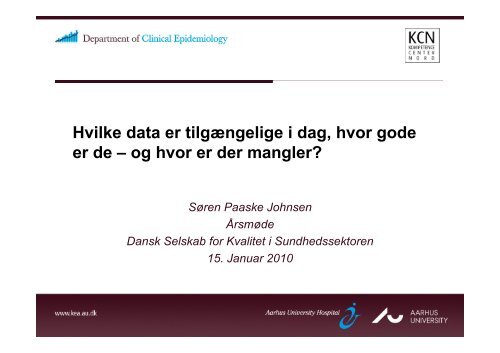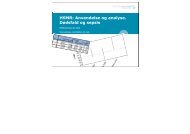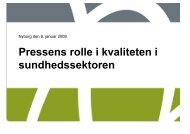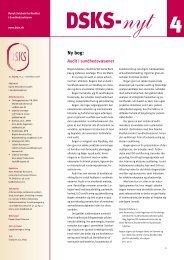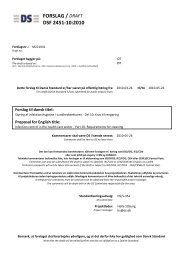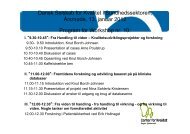Hvilke data er tilgængelige i dag, hvor gode er de - DSKS - Dansk ...
Hvilke data er tilgængelige i dag, hvor gode er de - DSKS - Dansk ...
Hvilke data er tilgængelige i dag, hvor gode er de - DSKS - Dansk ...
Create successful ePaper yourself
Turn your PDF publications into a flip-book with our unique Google optimized e-Paper software.
<strong>Hvilke</strong> <strong>data</strong> <strong>er</strong> <strong>tilgængelige</strong> i <strong>dag</strong>, <strong>hvor</strong> <strong>go<strong>de</strong></strong><br />
<strong>er</strong> <strong>de</strong> – og <strong>hvor</strong> <strong>er</strong> d<strong>er</strong> mangl<strong>er</strong>?<br />
Søren Paaske Johnsen<br />
Årsmø<strong>de</strong><br />
<strong>Dansk</strong> Selskab for Kvalitet i Sundhedssektoren<br />
15. Januar 2010
• Tilgængelige <strong>data</strong><br />
• Styrk<strong>er</strong> og svaghed<strong>er</strong> ved eksist<strong>er</strong>en<strong>de</strong> <strong>data</strong>kild<strong>er</strong><br />
• Gen<strong>er</strong>elt<br />
• Udvalgte eksempl<strong>er</strong><br />
• Konklusion
Har vi <strong>de</strong> <strong>data</strong> vi skal bruge i sundhedsvæsenet?
Eksempl<strong>er</strong> på <strong>data</strong>kild<strong>er</strong><br />
• NIP<br />
• Landsdækken<strong>de</strong> kliniske kvalitets<strong>data</strong>bas<strong>er</strong><br />
• Den Landsdækken<strong>de</strong> Und<strong>er</strong>søgelse af Patientoplevels<strong>er</strong> (LUP)<br />
• Landspatientregist<strong>er</strong>et/Lokale patientadministrative system<strong>er</strong><br />
• CPR regist<strong>er</strong>et<br />
• Patologiregist<strong>er</strong><br />
• Canc<strong>er</strong>regist<strong>er</strong>et<br />
• Fødselsregist<strong>er</strong>et<br />
• Dødsårsagsregist<strong>er</strong>et<br />
• Sygesikringen<br />
• Lægemid<strong>de</strong>l<strong>data</strong>bas<strong>er</strong><br />
• Laboratorie<strong>data</strong>bas<strong>er</strong><br />
• Mikrobiologiske registr<strong>er</strong>ingssystem<strong>er</strong><br />
• Billeddiagnostiske registr<strong>er</strong>ingssystem<strong>er</strong><br />
• Blodbankssystem<strong>er</strong>
Mulighed<strong>er</strong> for kobling af <strong>data</strong><br />
Canc<strong>er</strong>regist<strong>er</strong>et<br />
Kliniske<br />
kvalitets<strong>data</strong>bas<strong>er</strong><br />
CPR regist<strong>er</strong>et<br />
<br />
Landspatientregist<strong>er</strong>et<br />
Patologiregist<strong>er</strong>et<br />
Dødsårsagsregist<strong>er</strong>et<br />
Fødselsregist<strong>er</strong>et
Datakild<strong>er</strong> i et historisk p<strong>er</strong>spektiv<br />
1645 Kirkebøg<strong>er</strong><br />
1769 Den første folketælling<br />
1856 Første sygdomsregist<strong>er</strong> –Det Norske Lepra Regist<strong>er</strong><br />
1924 Folk<strong>er</strong>egist<strong>er</strong>et<br />
1925 C<strong>er</strong>ebral pares<strong>er</strong>egist<strong>er</strong>et<br />
1937 Tub<strong>er</strong>kulos<strong>er</strong>egist<strong>er</strong>et<br />
1943 Canc<strong>er</strong>regist<strong>er</strong>et<br />
1943 Dødsårsagsregist<strong>er</strong>et<br />
1953 Det Psykiatriske Centralregist<strong>er</strong><br />
1968 CPR regist<strong>er</strong>et<br />
1973 Medicinsk Fødselsregist<strong>er</strong><br />
1977 Landspatientregist<strong>er</strong>et
EP I DEMIO LO GY<br />
For years, any woman who got an abortion had to<br />
accept more than the loss of h<strong>er</strong> fetus: For some<br />
unknown reason, she also faced an elevated risk<br />
for breast canc<strong>er</strong>. At least that was w hat sev<strong>er</strong>al<br />
small case -control studies had suggested before<br />
Mads Melbye, an epi <strong>de</strong>miologist at the Statens<br />
S<strong>er</strong>um Institute in Copenhagen, und<strong>er</strong>took the<br />
largest effort ev<strong>er</strong> to explore the link. He and<br />
his col leagues obtained records on 400,000<br />
women in Den mark's national Abortion<br />
Regist<strong>er</strong>, then checked how many of the same<br />
women w<strong>er</strong>e listed in the Danish Canc<strong>er</strong><br />
Regist<strong>er</strong>. Their foray into the two <strong>data</strong>bases<br />
led to a surprising result: As they reported<br />
in The New England Journal of Medicine in<br />
1997, th<strong>er</strong>e appe ars to be no connection<br />
between abortion and breast canc<strong>er</strong>.<br />
Their success und<strong>er</strong>scores the value of a trove<br />
of <strong>data</strong> the Danish gov<strong>er</strong>nment has ac cumulated<br />
on its citizenry, which today totals about 5<br />
million people. Oth<strong>er</strong> Scandinavian countries<br />
have created pow<strong>er</strong>ful <strong>data</strong>base systems, but<br />
Denmark has earned a preemi nent reputation for<br />
possessing the most com plete and int<strong>er</strong>woven<br />
collection of statistics touching on almost ev<strong>er</strong>y<br />
aspect of life. The Danish gov<strong>er</strong>nment has<br />
compiled nearly 200 <strong>data</strong>bases, sonic be gun in the<br />
1930s, on ev <strong>er</strong>ything from medical records to<br />
socio economic <strong>data</strong> on jobs and salaries.<br />
What makes the <strong>data</strong>bases a phun research tool<br />
is the fact that they can all be linked by a 10 -<br />
.<br />
When an Entire Country<br />
Is a Cohort<br />
Denmark has gath<strong>er</strong>ed more <strong>data</strong> on its citizens than any oth<strong>er</strong> country. Now<br />
scientists are pushing to make this vast array of statistics even more useful<br />
digit p<strong>er</strong>sonal i<strong>de</strong>ntification numb<strong>er</strong>, called<br />
the CPR, that follows each Dane from cradle to<br />
grave. According to Melbye, "our regist<strong>er</strong>s allow<br />
for instant, large cohort studies that are<br />
impossible in most countries.<br />
Beauty in numb<strong>er</strong>s. These Danish twins starred in a vari ety<br />
show at the turn of the 20th century; n ow it's their medical<br />
records, part of a <strong>data</strong>base, that are in <strong>de</strong>mand.<br />
But Melbye and oth<strong>er</strong> scientists think they<br />
can extract even more from this <strong>data</strong> gold<br />
mine. They argue that not enough money is being<br />
spent on maintaining and expanding existing<br />
<strong>data</strong>base s, and they say that red tape is<br />
hamp<strong>er</strong>ing studies that require correlation of<br />
health and <strong>de</strong>mographic <strong>data</strong>. The problem is<br />
that, while they have unfett<strong>er</strong>ed access to more<br />
than 80 medical <strong>data</strong>bases maintained<br />
by the Danish Board of Health and public<br />
hospita ls, their use of 120 <strong>de</strong>mographic<br />
<strong>data</strong>bases ov<strong>er</strong>seen by the agency Statistics<br />
Denmark is tightly restricted. Statistics Den mark<br />
won't allow research<strong>er</strong>s to remove from its<br />
premises <strong>data</strong> co<strong>de</strong>d by CPR, and the pro cedures<br />
for accessing information at all are unwieldy<br />
and expensive.<br />
Statistics D<strong>er</strong>unark officials are reluctant to<br />
release <strong>data</strong> tied to CPRs, citing privacy<br />
conc<strong>er</strong>ns. "The public should have confi <strong>de</strong>nce<br />
that information i<strong>de</strong>ntifying them as individuals<br />
does not resi<strong>de</strong> outsi<strong>de</strong> of this in stitution," s ays<br />
the agency's Otto And<strong>er</strong>sen.<br />
Last month, Danish research minis<br />
t<strong>er</strong> Birte Weiss formed a committee<br />
to break the impasse. Denmark's<br />
<strong>data</strong>bases are "a resource which<br />
can be used more optimally," she<br />
told Science. "This should be a sci<br />
entific flagship."<br />
Working the health <strong>data</strong>bases<br />
can yield pow<strong>er</strong>ful results. For years<br />
the U.S. National Institutes of Health w<br />
has supported a study following z<br />
twins, hoping to tease out the rela<br />
tive contributions of genes and o<br />
lifestyle to aging. Led by Univ<strong>er</strong>sity a<br />
of S outh<strong>er</strong>n Denmark g<strong>er</strong>ontologist<br />
Kaare Christensen, the project has<br />
tapped the Danish Twin Regist<strong>er</strong>, f<br />
which inclu<strong>de</strong>s 110,000 pairs of<br />
twins born since 1870. Aft<strong>er</strong> follow<br />
ing more than 2000 pairs of twins aged 70 or z<br />
old<strong>er</strong>, Christensen's group has so far ti ed to 0 genes<br />
about a quart<strong>er</strong> of the variation in hu man<br />
longevity. "The project is ma<strong>de</strong> possible by the<br />
unmatched age and completeness of the Danish<br />
twin Regist<strong>er</strong>," lie says. o<br />
The health <strong>data</strong>bases have proven invalu able<br />
for probing contradictions raised by small<strong>er</strong><br />
studies and following disease pro -
”P<strong>er</strong>haps the best population-based <strong>data</strong> sources are<br />
the extensive <strong>data</strong> linkage networks in the<br />
Scandinavian countries. The availability of such<br />
registries for the virtually entire population is an<br />
invaluable resource for epi<strong>de</strong>miologic investigation”<br />
Michael S. Kram<strong>er</strong>. Clinical Epi<strong>de</strong>miology and<br />
Biostatistics 1988
For<strong>de</strong>le ved registre<br />
♦ Data indsamles all<strong>er</strong>e<strong>de</strong><br />
♦ Vil ofte dække hele målpopulationen<br />
♦ Mulighed for at følge patient<strong>er</strong> ov<strong>er</strong> lang tid<br />
♦ Lavt ressourceforbrug
Svaghed<strong>er</strong> ved registre<br />
♦ Vigtige <strong>data</strong> <strong>er</strong> ikke nødvendigvis <strong>tilgængelige</strong>, f.eks. livsstilsfaktor<strong>er</strong><br />
og funktionsscores.<br />
♦ Potentielt problem<strong>er</strong> vedr. <strong>data</strong>kvalitet
”Assumptions are the moth<strong>er</strong> of all<br />
fuck-ups”<br />
Und<strong>er</strong> Siege 2 (Kapring i høj fart)
Hvordan bedømm<strong>er</strong> vi værdien af en <strong>data</strong>kil<strong>de</strong>?<br />
• Komplethed af patientregistr<strong>er</strong>ing<br />
• Komplethed og validitet af variabelregistr<strong>er</strong>ing<br />
• Tilfældig variation<br />
• Systematiske fejl<br />
• Tilgængelighed<br />
• Juridisk<br />
• Teknisk<br />
• Administrativt
Eksempel: Registr<strong>er</strong>ing af medicinske komplikation<strong>er</strong><br />
hos patient<strong>er</strong> indlagt med apopleksi<br />
Ref: Ingeman et al., Clin Epi<strong>de</strong>miol 2010, in press
Eksempel: Hvor mange KOL-indlæggels<strong>er</strong> gemm<strong>er</strong> sig blandt<br />
patient<strong>er</strong> kun ko<strong>de</strong>t med lungebetæn<strong>de</strong>lse ell<strong>er</strong> respirations-svigt?<br />
• 18.657 indlæggelsesforløb i Danmark 1/1-30/9 2008 med<br />
diagnoseko<strong>de</strong> lungebetæn<strong>de</strong>lse ell<strong>er</strong> respirations-svigt, men u<strong>de</strong>n<br />
diagnoseko<strong>de</strong> KOL<br />
• Journalgennemgang af 1.543 af disse forløb i NIP-KOL-regi<br />
• Resultat: I 19% af forløbene hav<strong>de</strong> patienten KOL, u<strong>de</strong>n at diagnosen<br />
var registr<strong>er</strong>et<br />
• Konklusion: bety<strong>de</strong>lig und<strong>er</strong>registr<strong>er</strong>ing af akutte KOL indlæggels<strong>er</strong> i<br />
Danmark<br />
Ref<strong>er</strong>ence: NIP KOL National auditrapport 2009 (www.sundhed.dk)
Hvad betyd<strong>er</strong> forskellige DRG takst<strong>er</strong> for forskellig kodning<br />
af samme tilstand? Erfaring fra NIP KOL: meget…<br />
Diagnoseko<strong>de</strong> Tekst DRG takst 2009 i kr.<br />
J44.0 Kronisk obstruktiv<br />
lungesygdom m<br />
akut nedre<br />
luftvejsinfektion<br />
(0-59 år)<br />
J18.9 Lungebetæn<strong>de</strong>lse<br />
u<strong>de</strong>n specifikation<br />
J22.9 Akut nedre<br />
luftsvejsinfektion<br />
u<strong>de</strong>n specifikation<br />
16.395 kr.<br />
22.063 kr.<br />
40.189 kr.
Positiv prædiktiv værdi af udvalgte diagnos<strong>er</strong> i<br />
Landspatientregist<strong>er</strong>et<br />
Anafylactic shock<br />
Crohn's disease<br />
Diabetes<br />
Ulc<strong>er</strong>ative colitis<br />
Myocardial infarction<br />
H<strong>er</strong>niated lumbal disc<br />
Meningococcal disease<br />
Liv<strong>er</strong> cirrhosis<br />
Canc<strong>er</strong> diagnoses<br />
Essential hyp<strong>er</strong>tension<br />
Rheumatic fev<strong>er</strong><br />
Conn's syndrome<br />
Traumatic hip luxation<br />
Ut<strong>er</strong>ine rupture<br />
0 10 20 30 40 50 60 70 80 90 100
Hvordan komm<strong>er</strong> vi vid<strong>er</strong>e?
Eksempel: Kombin<strong>er</strong>et <strong>data</strong>indsamling<br />
• Etabl<strong>er</strong>et af Århus Amt/Region Midtjylland<br />
• Fø<strong>de</strong>system til NIP-diabetes<br />
• I drift fra maj 2006 på diabetesambulatori<strong>er</strong><br />
• Udnytt<strong>er</strong> fuldt ud <strong>data</strong> fra sygehusenes laboratoriesystem<strong>er</strong> samt<br />
sygesikringens ordinations- og y<strong>de</strong>lses<strong>data</strong>base.<br />
• Udfyld<strong>er</strong> en stor <strong>de</strong>l af NIP skemaet automatisk.<br />
• Rest<strong>er</strong>en<strong>de</strong> <strong>data</strong> indtastes af læge/sygeplej<strong>er</strong>ske (inkl. rygevan<strong>er</strong>, BMI<br />
og blodtryk).<br />
• Oprin<strong>de</strong>lig blev <strong>de</strong>t estim<strong>er</strong>et, at <strong>de</strong>t manuelt ville tage ca. 8 minutt<strong>er</strong><br />
at udfyl<strong>de</strong> skemaet, plus ti<strong>de</strong>n til at fremsøge relevante <strong>data</strong> i<br />
patientens journal. Med <strong>de</strong>n nye løsning brug<strong>er</strong> ambulatori<strong>er</strong>ne typisk<br />
1-2 minutt<strong>er</strong> på skemaet, ligesom ti<strong>de</strong>n til <strong>data</strong>søgning i patientens<br />
journal <strong>er</strong> reduc<strong>er</strong>et væsentligt.
Eksempel: Registr<strong>er</strong>ing af NMSC i Speciallægepraksis<br />
Sundhedsstyrelsens<br />
elektroniske indb<strong>er</strong>etningssystem
Eksempel: Registr<strong>er</strong>ing af NMSC i Speciallægepraksis<br />
Den kliniske <strong>data</strong>base for NMSC<br />
Sundhedsstyrelsens<br />
elektroniske indb<strong>er</strong>etningssystem
Eksempel: Registr<strong>er</strong>ing af NMSC i Speciallægepraksis<br />
Den kliniske <strong>data</strong>base for NMSC<br />
Sundhedsstyrelsens<br />
elektroniske indb<strong>er</strong>etningssystem
Konklusion<br />
• Det danske sundhedsvæsen <strong>er</strong> begunstiget af adgang til<br />
omfatten<strong>de</strong> mængd<strong>er</strong> af værdiful<strong>de</strong> <strong>data</strong>.<br />
• Bety<strong>de</strong>ligt potentiale for at anven<strong>de</strong> disse <strong>data</strong> til<br />
kvalitetsudvikling og forskning.<br />
• Kritisk og kreativ tilgang til <strong>data</strong> nødvendig for at sikre et<br />
validt og brugbart informationsgrundlag.


